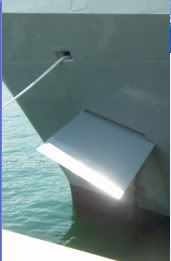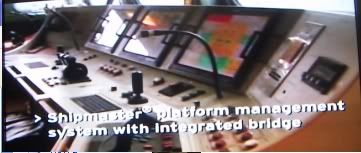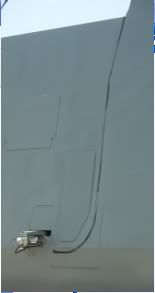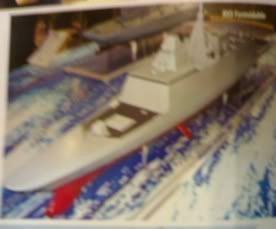Frigate:FFS,radar,stablizing fins etc
-
1.FSS and look slike a small fish boat on radar
It is official ---RSS Formidable,FFS 68!
What does FSS stand for?
Frigate Ship Singapore?
Frigate Small?
2.Rotating Radar
3.Stabilizing fins--first in RSN
4.Anchor cover
5.Stealth technology
6.Shipmaster platform management sys
7.CCTV and Gap
-
Farking freakish stealth frigate...

Jking, maybe it stands for Future Frigate System? -
What does ffs stand for? small frigate.

-
FFS, then FSS, then FFS again and then FSS again ... ??
FFS ... For Farks Sake! ...
Anyhoo, my guess ...
FF = Frigate
S = Stealth
lionnoisy,
Dude, point 5 ... I don't think the scans you put up relate to the Formidable at all.
"Use of Waterjet propulsion to minimise vibration and noise" ... huh? -
Actually, 3000 odd tons is pretty standard displacement for a frigate ...Originally posted by YI:What does ffs stand for? small frigate.
Small will be 2000 odd tons and large will be 4000 plus tons. -
Originally posted by kotay:
2.It is very relevant.can experts here tell us how Waterjet
lionnoisy,
Dude, point 5 ... I don't think the scans you put up relate to the Formidable at all.
"Use of Waterjet propulsion to minimise vibration and noise" ... huh?[/b]
can reduce vibration and noise. -
I'm not saying the point is invalid per se ... just that it's not relevant to the Formidable frigate.
The Formidable class uses constant pitch props ... not waterjets. hence the
-
The shroud over the propeller blocks most of the noise and cavitations.Originally posted by lionnoisy:2.It is very relevant.can experts here tell us how Waterjet
can reduce vibration and noise.
Imagine a fan with a short over it. Most of the noise will be blocked. -
Would you please stop this nonsensical posting of this? What are you? A retarded spambot?Originally posted by Botter:


-
Water jets do not use propellers.. no shrouds too. Instead, they use 'impellers' and are housed in a 'housing'..Originally posted by Fingolfin_Noldor:The shroud over the propeller blocks most of the noise and cavitations.
Imagine a fan with a short over it. Most of the noise will be blocked.
-
It isn't exactly a propeller but something similar. An impeller is a small propeller. There isn't anything else that can drive water at a high pressure outward. I have yet to hear of a water pump capable of driving water at speeds fast enough to push a 4000 tonne warship.Originally posted by siaokao:Water jets do not use propellers.. no shrouds too. Instead, they use 'impellers' and are housed in a 'housing'..
It has a shroud which is the housing. The Housing act as a sound absorber.
There's a nice drawing here: http://en.wikipedia.org/wiki/Water_jet_%28propulsion%29 -
re:papa 5 in my opening posting:
Use of Waterjet propulsion to minimise vibration and noise
2.It is very good indeed for PV in RSN.I think
RSN taps on PV experiences.The PVs are also installed with the water-jet propulsion system. Unlike propeller-driven vessels, the water-jet system enhances the manoeuvrability of the PVs, produces less noise and is more economical and easy to maintain.
--http://www.mindef.gov.sg/imindef/news_and_events/nr/1996/oct/05oct96_nr.html -
Hi, here is a link that I believe explains waterjet better. If I'm not wrong, RSN uses their jets.Originally posted by Fingolfin_Noldor:It isn't exactly a propeller but something similar. An impeller is a small propeller. There isn't anything else that can drive water at a high pressure outward. I have yet to hear of a water pump capable of driving water at speeds fast enough to push a 4000 tonne warship.
It has a shroud which is the housing. The Housing act as a sound absorber.
There's a nice drawing here: http://en.wikipedia.org/wiki/Water_jet_%28propulsion%29
http://www.hamjet.co.nz/index.cfm/The_Hamilton_Waterjet/How_a_Waterjet_Works.html
Waterjets are indeed large waterpumps.. Cheers.
-
2.thanks for info.Originally posted by siaokao:Hi, here is a link that I believe explains waterjet better. If I'm not wrong, RSN uses their jets.
http://www.hamjet.co.nz/index.cfm/The_Hamilton_Waterjet/How_a_Waterjet_Works.html
Waterjets are indeed large waterpumps.. Cheers.

18m Aluminium,Twin HM521 waterjets,40 knots,Singapore -
It's not all hamilton ... Don't forget Kamewa ...
-
I believe we use Kamewa for our boats in general.Originally posted by kotay:It's not all hamilton ... Don't forget Kamewa ... -
With a small propeller/impeller/orwhateveryouwanttocallti inside......... if you actually looked at the picture properly...Originally posted by siaokao:Hi, here is a link that I believe explains waterjet better. If I'm not wrong, RSN uses their jets.
http://www.hamjet.co.nz/index.cfm/The_Hamilton_Waterjet/How_a_Waterjet_Works.html
Waterjets are indeed large waterpumps.. Cheers.
-
EW and Sylver® vertical launch modules --http://www.dcn.fr/us/offre/batiments_surface/formidable.html
..The combat system offers exceptionnal capabilities for anti-air, anti-surface, anti-submarine and electronic warfare, as well as network-centric warfare (NCW...
2.SYLVER
Sylver®
vertical launch modules : 4...
Naval Vertical Launch System
3.HERAKLES is ThalesÂ’ latest multifunction radar, pdf file----http://www.thales-naval.com/naval/pdf/herakles1.pdf
MULTIFUNCTION 3D SURVEILLANCE AND FIRE CONTROL RADAR -
Any1 notice tat everything tat produce noise r mounted on shock mounts
-

can the FFS make a 180 degree turn in a length 3 times of her size,like PV?
2.Waterjet Advantages--http://www.hamjet.co.nz/index.cfm/The_Hamilton_Waterjet/Waterjet_Advantages.html

-
Originally posted by lionnoisy:
Waterjet sucks! Really sucks,even jelly fish also sucks up..
can the FFS make a 180 degree turn in a length 3 times of her size,like PV?
2.[b]Waterjet Advantages--http://www.hamjet.co.nz/index.cfm/The_Hamilton_Waterjet/Waterjet_Advantages.html
 [/b]
[/b]
And is damm slow compare to propeller ships! Especially big ships.. -
Maybe you'll change your mind after reading the below ...Originally posted by zenden9:Waterjet sucks! Really sucks,even jelly fish also sucks up..
And is damm slow compare to propeller ships! Especially big ships..
From US DOD DSTC - Section 13: Marine Systems Technology
Cavitation tends to degrade the performance of conventional fully wetted (submerged) propellers at speeds above 30 to 35 knots.
The waterjet is a different type of propulsor. As an alternative for countering propeller cavitation problems for high-speed craft and special-purpose craft, the waterjet, which is driven by a gas turbine, provides a jet-reactive thrust of high-velocity water expelled through a nozzle. With a speed range above 45 knots, waterjets, whose principal advantage is improvement of vehicle maneuverability over the whole speed range, are typically applied to patrol boats, surface effect ships, hydrofoils, and motor yachts. Kamewa waterjets have been installed on more than 500 craft since the early 1980Â’s. Experience of these units is reported by Kamewa to demonstrate other operational benefits (Croner, 1997):
- Good fuel economy. Above 20–25 knots usually competitive with propeller propulsion for the actual types of craft;
- Reduced internal noise and vibration levels compared to propeller propulsion. Noise reduction usually 7–10 dBA;
- Reduced hydroacoustic noise, usually about 10 dBA;
- Power absorption at constant rpm is insensitive to the shipÂ’s speed;
- Diesel engines are not over torqued or over speeded;
- Reduced engine wear;
- Cruising units can be used at full power during cruising as well as at top speed together with booster unit;
- Shallow draught and protected installation; and
- Well proven, reliable design. -
Stabilizing fins--first in RSN

